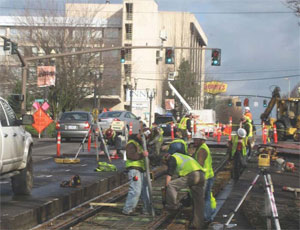The next phase of Portland Streetcar will be doing loops around downtown Portland upon its opening in 2012.
The 3.3-mi extension will add the east side to its service line, closing a loop of service long in the planning.


Total construction cost is $103 million; the total project cost including the streetcars and other equipment is $148.27 million.
“Getting the money was the biggest hurdle,” says Kay Dannen, media relations manager for Portland Streetcar Inc. “We were the first streetcar project in the country to be partially financed by the Federal government.” Other streetcar programs across the U.S. have since received federal aid, including Tucson’s proposed streetcar.
The project received $75 million from the federal government, $15.5 million from a local improvement district and $27.7 million from the Portland Development Commission. Funds from the state lottery will pay for six of the sleek streetcars, to be manufactured locally by United Streetcar LLC, a subsidiary of Clackamas-based Oregon Iron Works.
“We started this project in February 2003,” Dannen says. “It’s always hard to put the alignments and money together.”
Construction began last summer, with Alameda, Calif.-based Stacy and Witbeck, Inc. at the helm as construction manager/general contractor. Work includes the track plus a new 10,000-sq-ft maintenance facility for the streetcars, underneath the I-405 bridge.
The first step is performing advance utility work to relocate sewer, water and private utilities, with subcontractors doing the bulk of the public work and Portland-based owner’s representative Shiels Obletz and Johnsen coordinating private utilities such as fiber optics and gas. “We get all the advance utilities out of the way so it doesn’t delay us doing the track work,” says Steve Wood, Stacy and Witbeck’s project manager.
Once crews are ready to lay track, the contractor divides the work into three-block sections. “We try to do three blocks in three weeks,” Wood says. The strategy is driven by the need to minimize the impact to local businesses and to greatly minimize traffic congestion.
“We’ll saw-cut the track width for the concrete-encased track,” Wood says. “We typically cut a swath out that is 8 ft wide. We go down about 13 in. minimum and depending on the ground we might over-excavate a little bit just to get competent ground.”
Once crews prepare the sub-grade and install an aggregate base if necessary, workers will lay the rebar, put in the track at the correct elevation, add the form work and then pour the concrete. All this occurs in the first two weeks of...




Post a comment to this article
Report Abusive Comment